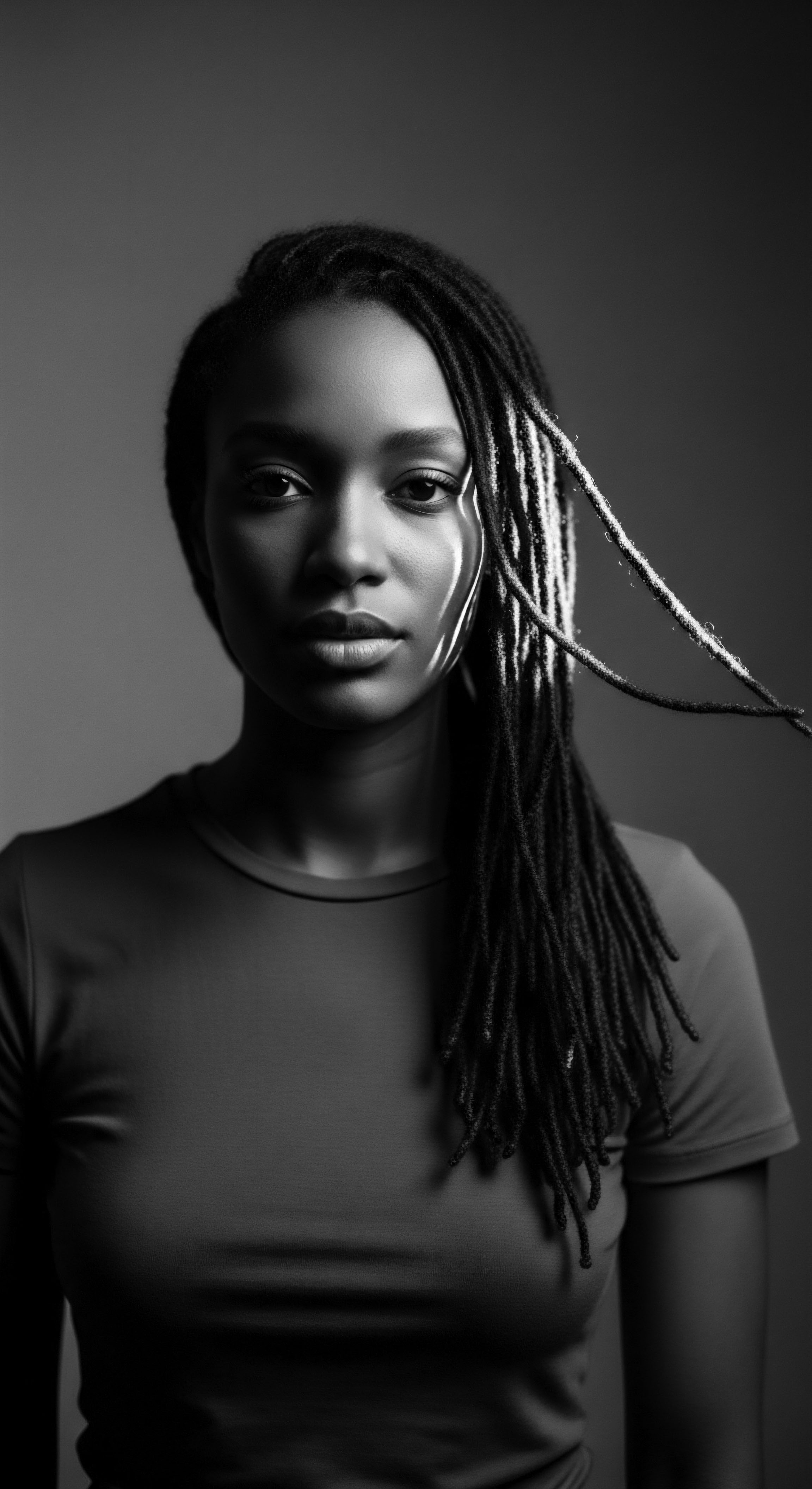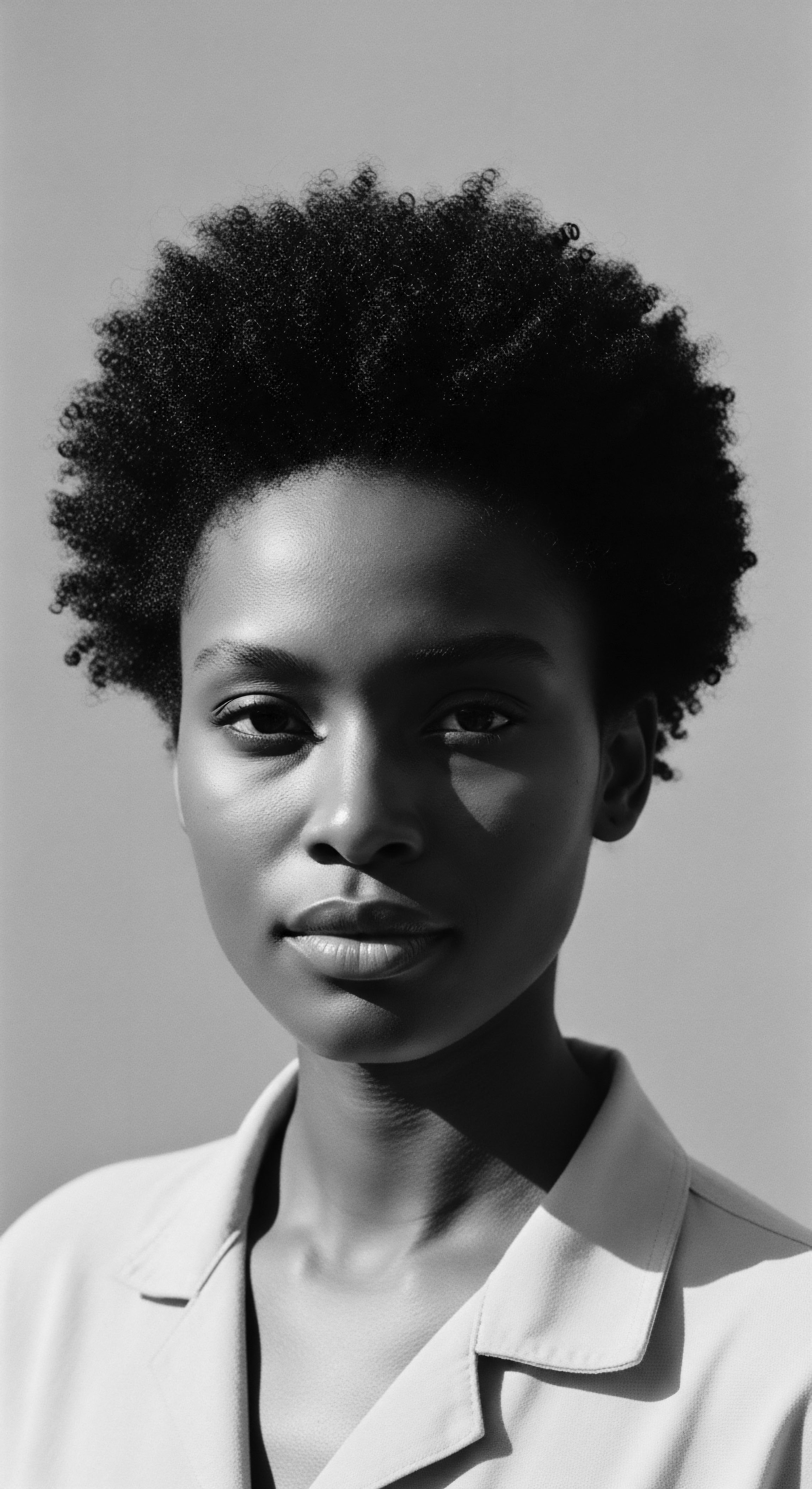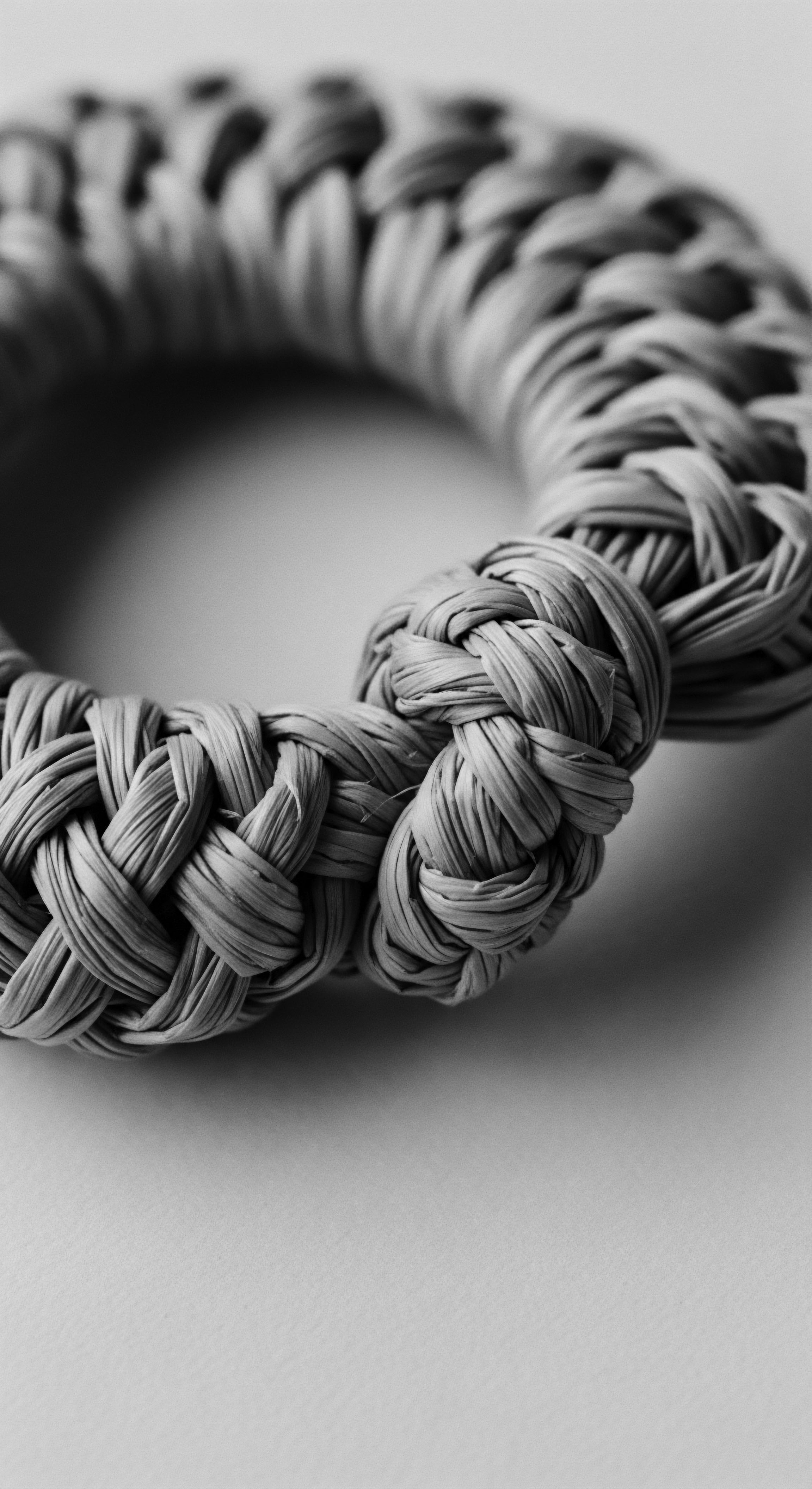
Roots
Standing at the genesis of hair’s story, particularly the story of textured hair, one begins to hear the quiet wisdom passed down through generations. It is a wisdom that acknowledges the profound connection between the strands on our heads and the earth beneath our feet. For ancestral communities across sun-drenched landscapes, protecting hair was not a mere act of vanity; it was a matter of survival, a preservation of identity, and a testament to ingenuity. The sun, a life-giver, also wielded a fierce power, its rays capable of drying and weakening hair.
Ancestral textured hair, with its unique coil structures and natural inclination towards dryness, faced a particular challenge in the face of relentless solar exposure. Here, certain natural oils emerged as steadfast guardians, silently shielding strands from environmental assault.
The very architecture of textured hair—its elliptical cross-section, the twists and turns of its helix—can lead to cuticle scales that are more open, allowing moisture to escape readily. This characteristic means that ancestral hair, without proper care, might quickly become dry and brittle in arid or intensely sunny environments. Such conditions leave the hair vulnerable to the sun’s ultraviolet (UV) radiation, which can degrade hair protein and lighten hair color.
Imagine, for a moment, the daily life of those who lived closely with nature ❉ farming under a scorching sky, migrating across open lands, or spending hours by communal fires. The need for a natural shield against these elements was not a luxury; it was an integral aspect of daily living and cultural preservation.

The Hair’s Elemental Shield
From time immemorial, the knowledge of plants and their healing properties served as the first line of defense. Ancestors observed, experimented, and codified which plant extracts provided the most benefit. These observations led them to oils that offered a protective film, reducing water loss and absorbing some of the sun’s damaging rays. The understanding of this protective quality was deeply embedded in their communal practices, a thread linking well-being to the gifts of the earth.
Ancestral wisdom recognized specific natural oils as essential shields for textured hair against relentless sun exposure, safeguarding both its vitality and cultural significance.

Understanding Textured Hair’s Natural Design
Textured hair encompasses a spectrum of patterns, from gentle waves to tight coils. Each curl, each bend, serves a unique purpose, contributing to the hair’s overall volume and strength. However, the very nature of these curls means that natural oils produced by the scalp struggle to travel down the hair shaft as effectively as they do on straighter hair types. This inherent characteristic means ancestral textured hair often required external lipid replenishment, a need that traditional oils met with profound efficacy.
The ancestral communities understood this intrinsic characteristic, even if not in modern scientific terms, and developed practices to counteract it, thus securing the health and symbolic power of their hair. The choice of oil often depended on local flora, climate, and collective wisdom passed down through generations.

Ritual
The application of natural oils to textured hair transcended simple cosmetic acts; it ascended into a realm of ritual, a daily dedication to ancestral wisdom and self-preservation. These practices were not isolated incidents but carefully choreographed rhythms within community life, often intertwined with social gatherings, rites of passage, and the transmission of knowledge from elder to youth. The sun, while providing warmth and life, also presented a significant challenge to hair health, particularly in regions where ancestral communities thrived under its direct gaze. The oils, then, became not just topical applications, but extensions of a deeper understanding of one’s place within the natural world and a continuation of an inherited legacy of care.

Ancestral Hand to Hair
Picture the scene ❉ women gathered under a great tree, perhaps a baobab, their hands moving with practiced grace through strands of hair, infusing them with rich, earthy scents of shea or coconut. This was more than grooming; it was a communal bonding, a sharing of stories, and a silent teaching of techniques honed over centuries. The oils were massaged in, braided in, and styled in, creating layers of protection both tangible and spiritual. The warmth of the hands, the steady rhythm, the communal atmosphere—all contributed to a holistic experience, ensuring the oils penetrated and performed their protective duties, especially against the sun’s pervasive influence.

Oils for the Sun’s Embrace
Different regions favored different oils, each chosen for its particular properties and availability. These were not arbitrary choices; they were selections guided by generations of observation and collective experience. The oils served to create a physical barrier on the hair shaft, a film that could scatter or absorb some of the incoming UV radiation.
Beyond this direct shield, they also helped to seal the hair’s cuticle, reducing the evaporation of natural moisture and preventing the dryness and brittleness that solar exposure can bring. The wisdom was practical, rooted in what worked, what healed, and what preserved.
- Shea Butter ❉ From the nuts of the shea tree (Vitellaria paradoxa), predominantly found in West Africa, this rich butter offered centuries of protection. It was traditionally used to shield skin and hair from the harsh sun, wind, and dust, providing deep moisturization and possessing mild natural UV protective properties (Falconi, as cited in Shea Butter.net, n.d.). The women who extract it, often called “women’s gold” for their labor, have used it for generations for its ability to moisturize and condition hair.
- Coconut Oil ❉ A staple in tropical and coastal communities, coconut oil boasts a long history of use for hair care, helping to strengthen hair, manage dry scalp, and protect against sun damage. Its ability to penetrate the hair shaft distinguishes it, offering a deeper layer of protection and helping to prevent protein loss from sun exposure.
- Argan Oil ❉ Hailing from Morocco, argan oil has been cherished for its ability to nourish and protect skin and hair from arid elements. It contains antioxidants like Vitamin E and ferulic acid, which contribute to its capacity to fight off UV exposure and environmental stressors. Women in cooperatives traditionally process this “liquid gold” for its protective qualities.
- Marula Oil ❉ From southern and West Africa, marula oil is noted for its lightness, fast absorption, and high antioxidant content, including vitamins C and E. It has been used for centuries for its healing and moisturizing properties, and it forms a barrier against heat styling and UV rays, reducing breakage and dryness.
- Baobab Oil ❉ Extracted from the seeds of the “Tree of Life” native to Africa, baobab oil has been used for centuries to moisturize skin and hair, and shield it from the sun. Rich in vitamins A, D, E, and F, along with essential fatty acids, it nourishes and restores, embodying a deep connection to resilience and ancient wisdom.
- Palm Oil ❉ Especially red palm oil, recognized for its high concentration of carotenoids like beta-carotene, has been used to nourish and moisturize hair. It acts as a natural shield, creating a protective barrier against UV rays and environmental pollutants. Historically, it softened hair and supported a healthy scalp environment.
- Moringa Oil ❉ Known as the “miracle tree” in Africa and Asia, moringa oil, derived from its seeds, acts as a protectant from sun damage and hair color fading. It is rich in antioxidants, essential fatty acids, and vitamins, forming a protective barrier against UV rays and pollution.
The collective wisdom of ancestral communities guided the selection and application of natural oils, turning hair care into a ceremonial art deeply rooted in environmental protection.
The practice extended beyond simply applying oil. It often involved intricate styling that further aided protection. Braids, twists, and various forms of coiling or wrapping hair served to enclose the hair, minimizing direct exposure to the sun and environmental factors.
These styles, often imbued with social, cultural, and spiritual meaning, were therefore functional in their protection. The layered approach of internal oiling through natural lipids and external physical protection through styling represents a sophisticated, holistic system of care.

Relay
The ancestral knowledge surrounding natural oils and textured hair protection against sun damage holds a profound lineage, a relay of wisdom passed across generations, geographies, and the challenging currents of history. This wisdom, once purely observational and experientially validated, finds resonance and explanation in contemporary scientific understanding. The deep connection between these ancient practices and the biological reality of hair serves to solidify the authority of heritage in wellness, offering a counter-narrative to beauty standards that sometimes disregarded the inherent needs of textured strands.

How Do Natural Oils Guard Against Sun’s Rays?
The sun, a giver of life, also emits ultraviolet radiation, which can wreak havoc on hair. UV exposure degrades the protein structure of hair, particularly its keratin, leading to weakened strands, color changes, and increased porosity. Ancestral oils, through their unique compositions, provided a multi-pronged defense. Many plant oils contain natural antioxidants, such as tocopherols (Vitamin E) and carotenoids, which combat the free radicals generated by UV radiation, thus mitigating oxidative stress on the hair.
Furthermore, the fatty acid profiles of these oils create a physical barrier on the hair shaft, reflecting or absorbing some of the UV light before it can cause damage. This lipid layer also acts as an occlusive, sealing moisture within the hair, preventing the dehydration and brittleness that are common outcomes of sun exposure.

A Living Legacy of Protection
To truly grasp the significance, consider the Himba people of Namibia. For centuries, Himba women have adorned their hair and skin with a mixture known as Otjize Paste. This paste, a striking blend of ochre pigment, butterfat, and aromatic resins, serves a function far beyond adornment. Anthropological studies reveal its central role in protecting both skin and hair from the intense desert sun and harsh dry winds.
While primarily recognized for its deep reddish hue, the butterfat component—often derived from cow’s milk—provides a rich lipid layer, a practical shield against environmental elements. The use of natural fats in this manner illustrates a sophisticated, inherited understanding of sun protection within ancestral practices, a testament to observed effectiveness over generations. (Gomez, 2018, p. 75).
This Himba practice is not an isolated instance. Throughout diverse African communities, the strategic use of indigenous plant oils for hair protection became a staple. From the deep nourishing properties of shea butter, traditionally processed by women in West Africa for skin and hair protection against environmental stressors, to the light yet potent defense offered by marula oil in Southern Africa, these natural offerings were intelligently deployed. Coconut oil, a tropical bounty, has been historically used to reduce protein loss from hair and form a protective barrier against sun damage.
Palm oil, especially its red variant, with its high carotenoid content, acted as a natural shield against UV radiation, preserving hair health in sun-drenched regions. Moringa oil, often termed a “miracle oil,” also contributed to guarding against sun damage and color fading with its antioxidant properties.
The ingenuity lies not only in the selection of the oils but also in the method of their application, often integrated into protective styles like braids, twists, and elaborate coiffures that further minimized direct solar exposure. These hair practices were interwoven with cultural identity, social status, and spiritual beliefs, making hair care a holistic endeavor that protected the physical strand while also upholding cultural continuity. The preservation of these techniques represents a vital thread in the heritage of textured hair, a dialogue between ancient wisdom and the modern understanding of dermatological and trichological science.
| Traditional Oil Shea Butter |
| Ancestral Use for Protection Shielded hair from intense sun, wind, and dust, providing deep moisture. |
| Scientific Insight for Sun Defense Contains cinnamic acid which offers mild natural UV protection, alongside high vitamin A and E content to combat free radicals. |
| Traditional Oil Coconut Oil |
| Ancestral Use for Protection Applied to hair for strength, luster, and protection against environmental elements. |
| Scientific Insight for Sun Defense Penetrates hair shaft, reduces protein loss from UV exposure, forms a protective barrier, and minimizes water absorption. |
| Traditional Oil Argan Oil |
| Ancestral Use for Protection Valued for nourishing and guarding hair from arid conditions. |
| Scientific Insight for Sun Defense Rich in Vitamin E and ferulic acid, providing antioxidant defense against UV radiation and environmental stressors. |
| Traditional Oil Marula Oil |
| Ancestral Use for Protection Used for healing and moisturizing, also provided a barrier against environmental harm. |
| Scientific Insight for Sun Defense Boasts high levels of antioxidants (Vitamins C, E, flavonoids) that combat free radical damage from sun exposure; forms a protective layer. |
| Traditional Oil Baobab Oil |
| Ancestral Use for Protection Moisturized and helped shield hair from the sun in African communities. |
| Scientific Insight for Sun Defense Abundant in vitamins (A, D, E, F) and fatty acids, supporting hair integrity and offering protection against environmental stressors. |
| Traditional Oil Palm Oil |
| Ancestral Use for Protection Applied to soften hair and protect against sun exposure. |
| Scientific Insight for Sun Defense High in carotenoids (beta-carotene) and Vitamin E, powerful antioxidants that guard against UV radiation damage. |
| Traditional Oil Moringa Oil |
| Ancestral Use for Protection Used for hair strength, dryness, and environmental shielding. |
| Scientific Insight for Sun Defense Contains antioxidants and forms a protective barrier against UV rays and pollution, helping to prevent color fading and damage. |
| Traditional Oil These oils embody a heritage of protective care, demonstrating how ancestral wisdom aligns with modern scientific understanding in guarding textured hair. |
The scientific properties of ancestral oils, like their rich antioxidant content and barrier-forming capacities, validate their historical role in shielding textured hair from solar damage.
The journey of these oils from ancestral use to modern appreciation highlights an ongoing discovery, a testament to the enduring power of natural ingredients. Contemporary research often echoes the observations made by those who lived intimately with the land, providing molecular explanations for practices honed over millennia. The wisdom of those who first pressed the shea nut or extracted coconut oil, understanding their hair’s inherent needs and the environment’s demands, forms an indispensable chapter in the vast lexicon of textured hair care heritage.

Reflection
The narrative of what natural oils protected ancestral textured hair from sun damage is a profound meditation on adaptation, resilience, and the deep, living legacy of care. It is a story not confined to the scientific properties of fatty acids or antioxidant compounds, though these are certainly vital components. It speaks more broadly to the ingenuity of communities who, through generations of observation and practice, cultivated a profound understanding of their bodies, their environment, and the gifts of the earth around them. The practices illuminate how beauty and wellness were inextricably bound to survival and cultural identity.
The very strands of textured hair carry echoes of this journey. They whisper of the hands that meticulously applied shea butter under a Sahelian sun, of the communal gatherings where palm oil rituals solidified bonds, and of the journeys through landscapes where baobab oil offered a precious defense. The oils themselves, extracted with ancestral methods and applied with intention, were not merely emollients; they were conduits of wisdom, tangible links to a heritage that revered hair as a sacred adornment, a marker of lineage, status, and spirit.
This lineage reminds us that the quest for hair health today is not a new invention, but a continuation of an age-old dialogue between humanity and nature, a dialogue particularly resonant for those whose heritage is rooted in the rich tapestry of Black and mixed-race experiences. Every drop of oil, every careful application, becomes an act of honoring the past and shaping a vibrant future for textured hair, keeping the soul of a strand luminous across time.

References
- Falconi, M. (n.d.). A History of Shea Butter. sheabutter.net.
- Gomez, L. (2018). Bodily Ways of Knowing ❉ Anthropological and Historical Approaches to Affect and the Senses. Oxford Research Encyclopedia of African History.
- Islam, T. (2017). 7 African Ingredients and Rituals for Healthy and Flawless Skin. Malée.
- Karite Shea Butter. (n.d.). Karite Shea Butter ❉ The Women’s Gold.
- Kerharo, J. (n.d.). (Source on medicinal uses of shea butter for arthritis – likely an ethnographic or botanical text).
- MFTC. (2019). (Source on shea belt geography – likely a trade or agricultural report).
- NCBI. (Source on argan oil and sun-drying – likely a scientific paper on oil extraction).
- Randle, R. (2015). Hair Story ❉ Untangling the Roots of Black Hair in America. St. Martin’s Griffin.
- Rosado, C. (2003). Hair ❉ The Missing Identity Marker.
- Sieber, R. (2000). Hair in African Art and Culture. The Museum for African Art.
- Tella, A. (n.d.). (Source on medicinal uses of shea butter as nasal decongestant – likely a medical or ethnobotanical journal).
- Thomas, R. (2013). (Source on Black males and Western beauty standards – likely an academic paper on sociology or cultural studies).
